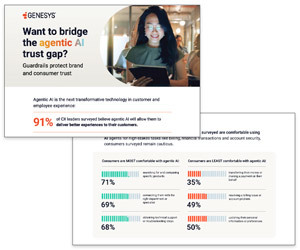Call volumes are often driven up by problems on other channels.
In fact, research shows that people would prefer not to phone a contact centre. They would rather try and solve a problem via the company’s website, via email or through other channels.
But the problem is that, all too often, the other channels do not provide the right answers or the right service level. This tends to drive up call volumes and call durations.
We ask our panel for their advice on how to overcome this issue.
Introducing new channels needs total commitment to work well
Offering your customers a choice of contact methods to gain service differentiation can backfire dramatically if the capability and capacity to address them efficiently hasn’t been implemented.
- Ensure that all channels are incorporated into the overall contact strategy and that channel-specific performance measurement criteria are identified and communicated to all advisors.
- Prioritise the implementation of contact tracking to capture all customer interactions so that advisors are equipped with a complete picture of the customer.
- As new channels are added, they need to be added to existing routing and reporting processes.
- Take steps to ensure customer expectations are matched to channel resource availability and response times are clearly articulated. Contact centres need to be multichannel operationally as well as technologically.
- Integration between channels is key, with silo elimination vital to ensure optimum levels are delivered across the whole operation.
- As non-traditional contact channels gain traction, you need to regularly monitor this and align your operation and resources to meet these fluctuations in channel volumes to eliminate any potential dips in service levels.

Cathy McAuley
Cathy McAuley, Marketing Communications Manager, Netcall
Drill down on root causes
If other channels are not providing the right answers or service levels there clearly needs to be some research into what the cause of dissatisfaction is in the first place or what is not being addressed via those channels.
A phone call is one of the few instances where you have a real-time dialogue between customer and contact centre. Other channels like websites and emails are more one-sided as there is often a delay in response or it can be open to misinterpretation, affecting customer service levels.
Even where you have live chat or a constant stream of dialogue via social channels, it could be that the issue is so complex or there are too many nuances to explain the situation succinctly that it still requires escalation to a phone call.
When those calls come in, it is an opportunity for the contact centre to use tools like speech analytics to drill down and identify call drivers and patterns which may be emerging where your customers are experiencing problems.
Speech analytics can be used to monitor different call types for phrases linked to complaints or customer dissatisfaction, allowing a business to pinpoint the activities that may be driving the calls in the first place. Analytics can provide the insight and trends, and can even enable real-time prompts to agents, to guide and improve the customer experience at that point of time.

Tracy McAvoy
Once a contact centre has a handle on what the main issues are and the different circumstances under which they originate they are better equipped to provide clearer answers and should be able to communicate these across the different channels, ultimately reducing the number of calls coming into the contact centre.
Tracy McAvoy, Marketing Manager, Business Systems (UK) Ltd
Many customers prefer to self-serve
To compete effectively in the modern market, businesses need to offer quality communications to customers on the channels most convenient for them.
Many customers would prefer to self-serve — solving their own queries and issues by finding information online — yet often information is not available. If self-service is unavailable, more and more consumers are wanting to communicate via eServices — email, website, social media.
Offering customers a communication channel they find convenient improves efficiencies and reduces costs. Gartner research found companies that introduced self-service had a 14% reduction in contact centre calls. This improved to 18% for those implementing a second channel and 25% for companies using web chat.
These channels need to offer the same level of service as customers would expect to receive when calling a company. This requires the same KPIs a company uses for its telephony, including quick response times and dispute resolution.
These channels must also be treated with the same priority; gone are the days when customer services would even think about responding to emails during quieter periods later in the week. Employing true multichannel queuing, where communications from all channels are listed together, makes responding on a first-come-first-served basis possible.
To ensure quality there also needs to be reporting, recording and monitoring. This information should then be attributed to customer files, so that agents can see what contact has been made and resolve issues more efficiently. This also enables the tracking of success and failure, to allow the creation of best practice. Routing channels to those with the best skills to deal with them, along with consistent corporate messaging and training, improves quality and responsiveness further. The written channels take a different mind-set from voice and often require the agent to handle multiple interactions simultaneously.

Dave Paulding
When looking for agents with the right skills to handle new channels, identify employees within the company. Typically, agents involved in eServices who started as voice agents have already learned the business, which makes it much easier to bring that new channel up to speed. An eServices team is often populated with more senior agents, often seen as an earned perk.
Finally, it is worth keeping an eye on developing channels and looking to see whether or not they should be integrated into an organisations communications strategy.
Dave Paulding, Regional Sales Director UK, Middle East & Africa, at Interactive Intelligence
Don’t just ‘bolt on’ other channels
The problem faced by a lot of companies when considering a multichannel contact strategy is that, having invested for years in the voice-only call centre, they often choose to bolt on other channels to move their call centre into a multichannel contact centre.
But a “bolt-on” approach usually leads to a disjointed customer experience and an administrative nightmare. The only way to provide a truly customer-centric solution is to have all channels driven and managed from a single business hub sharing data and processes.
This isn’t as difficult or as expensive as companies think and the value to the business is immeasurable.

Amanda Mone
Technology has moved on and there are solutions available that can augment existing systems and provide a fully integrated customer contact experience. Don’t try and cut corners by using shared email folders, a siloed web chat solution, a stand-alone social media application and an isolated web portal, all frantically managed by distributed agents across the business, whose gallant efforts to provide a consistent customer experience are doomed to fail. It’s a false economy.
Amanda Mone, Contact Centre Practice, mplsystems.
How do you manage poor service on other channels? Please leave your comments in an email to Call Centre Helper
Author: Jo Robinson
Published On: 16th Jan 2013 - Last modified: 15th Aug 2025
Read more about - Customer Service Strategy, Business Systems, Email, Genesys, IFS, Omnichannel, Self Service, Service Level, Service Strategy









































